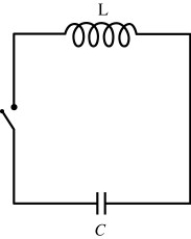Multiple Choice
A capacitor,initially having a charge Q on the left plate and a charge -Q on the right plate,is connected to a switch and an inductor,as shown in the figure.  Assuming the resistance of the circuit is zero,when the switch is closed,
Assuming the resistance of the circuit is zero,when the switch is closed,
A) charge will flow out of the capacitor until the left plate is no longer charged,and then all current ceases.
B) current will flow until the left plate of the capacitor has a charge -Q,and then current will flow in the opposite direction,reversing again when the left plate has a charge of +Q.The cycle will then repeat over and over.
C) current will flow through the inductor back and forth,with the magnitude of the current decreasing and eventually going to zero.
D) None of the above
Correct Answer:

Verified
Correct Answer:
Verified
Q12: In a series RLC circuit,the current is
Q13: An LC circuit has a resonance frequency
Q14: For circuits with either an inductor and/or
Q15: <img src="https://d2lvgg3v3hfg70.cloudfront.net/TB2706/.jpg" alt=" A series AC
Q16: Why is it not possible to have
Q18: An RLC circuit has a sinusoidal voltage
Q19: <img src="https://d2lvgg3v3hfg70.cloudfront.net/TB2706/.jpg" alt=" A series circuit
Q20: In a purely resistive AC circuit,when the
Q21: A circuit with alternating current has its
Q22: <img src="https://d2lvgg3v3hfg70.cloudfront.net/TB2706/.jpg" alt=" The 60 Hz